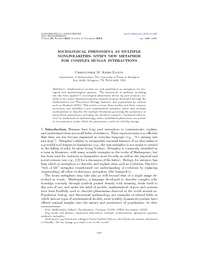
ATTENTION: The works hosted here are being migrated to a new repository that will consolidate resources, improve discoverability, and better show UTA's research impact on the global community. We will update authors as the migration progresses. Please see MavMatrix for more information.
Show simple item record
| dc.contributor.author | Kribs, Christopher | |
| dc.date.accessioned | 2014-08-27T19:05:38Z | |
| dc.date.available | 2014-08-27T19:05:38Z | |
| dc.date.issued | 2013 | |
| dc.identifier.citation | Published in Mathematical Biosciences and Engineering 10(5/6):1587-1607, 2013 | en_US |
| dc.identifier.issn | 1547-1063 | |
| dc.identifier.issn | 1551-0018 | |
| dc.identifier.uri | http://hdl.handle.net/10106/24561 | |
| dc.description.abstract | Mathematical models are well-established as metaphors for biological and epidemiological systems. The framework of epidemic modeling has also been applied to sociological phenomena driven by peer pressure, notably in two dozen dynamical systems research projects developed through the Mathematical and Theoretical Biology Institute, and popularized by authors such as Gladwell (2000). This article reviews these studies and their common structures, and identifies a new mathematical metaphor which uses multiple nonlinearities to describe the multiple thresholds governing the persistence of hierarchical phenomena, including the situation termed a ``backward bifurcation'' in mathematical epidemiology, where established phenomena can persist in circumstances under which the phenomena could not initially emerge. | en_US |
| dc.language.iso | en_US | en_US |
| dc.publisher | American Institute of Mathematical Sciences | en_US |
| dc.subject | Backward bifurcation | en_US |
| dc.subject | Multiple nonlinearities | en_US |
| dc.subject | Dynamical systems | en_US |
| dc.subject | Epidemic | en_US |
| dc.subject | Metaphor | en_US |
| dc.title | Sociological phenomena as multiple nonlinearities: MTBI's new metaphor for complex human interactions | en_US |
| dc.type | Article | en_US |
| dc.publisher.department | Department of Mathematics, University of Texas at Arlington | |
| dc.identifier.externalLink | http://aimsciences.org/journals/displayArticlesnew.jsp?paperID=8910 | en_US |
| dc.identifier.externalLinkDescription | The original publication is available at the journal homepage | en_US |
Files in this item
- Name:
- sociological phenomena.pdf
- Size:
- 273.2Kb
- Format:
- PDF
- Description:
- pdf
This item appears in the following Collection(s)
Show simple item record


